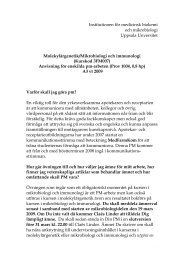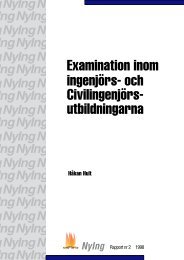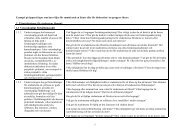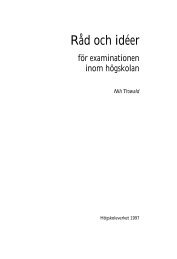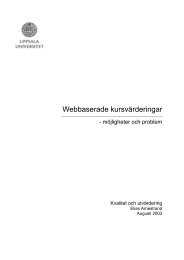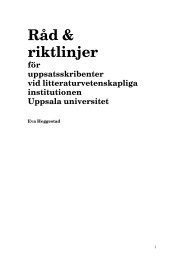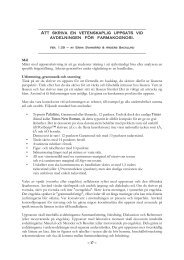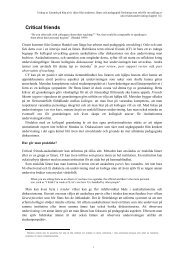Aligning teaching and assessment to curriculum objectives John Biggs
Aligning teaching and assessment to curriculum objectives John Biggs
Aligning teaching and assessment to curriculum objectives John Biggs
You also want an ePaper? Increase the reach of your titles
YUMPU automatically turns print PDFs into web optimized ePapers that Google loves.
it of factual information -- so <strong>and</strong> so did that,<strong>and</strong> concluded that -- for two sides of writing,then you’ll get a good mark. Quoted in Ramsden(1984: 144)If the teacher of this student thought that acritical evaluation of psychological theoriescould be h<strong>and</strong>led by selectively memorizing,there would be no problem. But surely theteacher didn’t think that. I hope not! As ithappened, this particular student graduatedwith First Class Honours. He liked writingextended essays, <strong>and</strong> held these quick <strong>and</strong>snappy <strong>assessment</strong>s in contempt. He made astrategic decision <strong>to</strong> memorise, knowing that itwas enough <strong>to</strong> get him through.The problem here? The <strong>assessment</strong> was notaligned <strong>to</strong> the aims of <strong>teaching</strong>. So often therhe<strong>to</strong>ric in courses <strong>and</strong> programmes is all thatit should be: students will graduate with a deepunderst<strong>and</strong>ing of the discipline, <strong>and</strong> the ability<strong>to</strong> solve problems creatively. Then they are <strong>to</strong>ldabout creative problem solving in packedlecture halls, <strong>and</strong> tested with multiple choicetests. It’s all out of kilter, but such a situationis not, I strongly suspect, all that uncommon.A good <strong>teaching</strong> environment is consistent.Teaching <strong>and</strong> <strong>assessment</strong> practices are aligned<strong>to</strong> the aims of <strong>teaching</strong>.So what does a goodsystem look like?Problem-based learning (PBL) is a very goodexample of aligned <strong>teaching</strong>. PBL is mostcommonly used in professional degreeprogrammes, such as architecture, medicine,<strong>and</strong> nursing, but it is also used on more‘academic’ programmes. The idea is thatgraduates should be able <strong>to</strong> performdifferently in the area of study on graduation,for example <strong>to</strong> solve professionally relatedproblems. In PBL, the main <strong>teaching</strong> method is<strong>to</strong> get the students <strong>to</strong> solve professionalproblems themselves (carefully selected as <strong>to</strong>difficulty <strong>and</strong> content), while the <strong>assessment</strong> isjudging how well they have solved them. Thereis alignment all the way through, from<strong>objectives</strong> through <strong>teaching</strong> method, <strong>to</strong><strong>assessment</strong>: all involve focusing on studentsdoing what they should be doing, solvingprofessional problems. Telling them the his<strong>to</strong>ryof architectural problem solving, or giving themmultiple choice tests on the knowledge needed<strong>to</strong> solve problems, or learning the principles ofproblem solving, might be interesting <strong>and</strong>useful, but they are not the central issue. Thecentral issue is putting knowledge <strong>to</strong> work.PBL is an excellent example of an alignedsystem, probably the purest example, but mostapproaches <strong>to</strong> <strong>teaching</strong> can be aligned moreeffectively than they are already.What is constructive alignment?CA has two aspects. The ‘constructive’ aspectrefers <strong>to</strong> what the learner does, which is <strong>to</strong>construct meaning through relevant learningactivities. The ‘alignment’ aspect refers <strong>to</strong> whatthe teacher does, which is <strong>to</strong> set up a learningenvironment that supports the learningactivities appropriate <strong>to</strong> achieving the desiredlearning outcomes. The key is that thecomponents in the <strong>teaching</strong> system, especiallythe <strong>teaching</strong> methods used <strong>and</strong> the <strong>assessment</strong>tasks, are aligned <strong>to</strong> the learning activitiesassumed in the intended outcomes. The learneris in a sense ‘trapped’, <strong>and</strong> finds it difficult <strong>to</strong>escape without learning what is intended shouldbe learned.In this Guide, let us focus on aligning asemester length unit or course. There are fourmajor steps.1. Defining the intended outcomes (the<strong>objectives</strong>)2. Choosing <strong>teaching</strong>/learning activitieslikely <strong>to</strong> lead <strong>to</strong> attaining the <strong>objectives</strong>



